
Summary
That brings us to the end of this chapter. Let's revisit what we have learned so far. We started off by looking at the relationship between AI, machine learning, and deep learning. Then, we implemented a demo of deep learning by classifying an image and then implementing a text to speech conversion using a Google API. This was followed by a brief description of different use cases and types of deep learning, such as MLP, CNN, RNN, and GANs.
In the next section, we were introduced to the TensorFlow framework and understood some of the basic building blocks, such as tensors and their rank and shape. We also implemented different linear algebra operations using TensorFlow, such as matrix multiplication. Later in the chapter, we performed some useful operations such as reshape and argmax. Finally, we were introduced to the concept of optimizers and implemented solutions for mathematical expressions using optimizers.
Now that we have laid the foundations for deep learning and introduced you to the TensorFlow framework, the stage has been set for you to take a deep pe into the fascinating world of neural networks. In the next chapter, you will be introduced to neural networks, and in the successive chapters, we will take a look at more in-depth deep learning concepts. We hope you enjoy this fascinating journey.